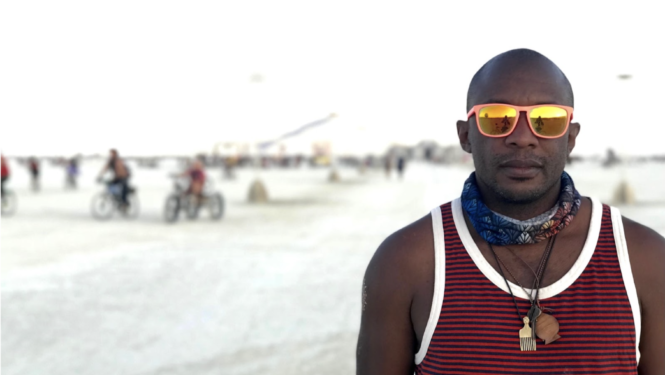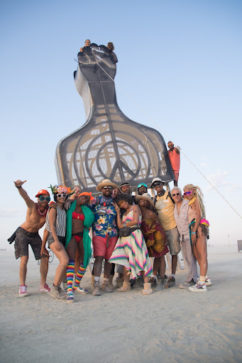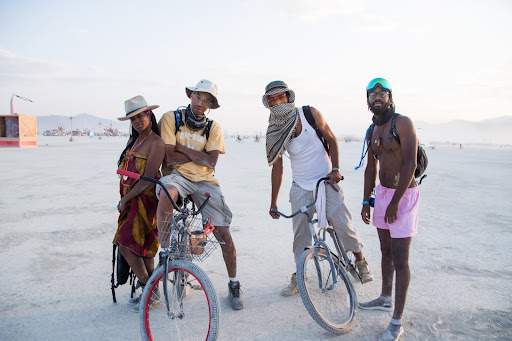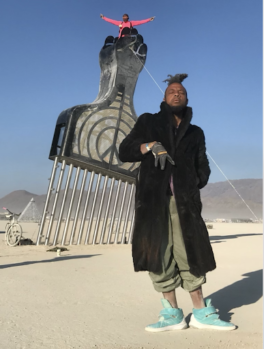“The real reason to go to Burning Man is to spend time and reconnect with yourself, the universe, and the world. Really clear your thoughts and face those things you avoid, the things that keep you from doing those things aren’t at Burning Man.”
—Hank Willis Thomas

Many of us know Hank Willis Thomas as the conceptual artist behind “All Power to All People,” produced in collaboration with Marsha Reid of Kindred Arts, Jayson Jackson on the presentation, and fabrication by the Letter Factory with Jeff Schomberg. The production team included Jeffrey Schomburg, William Sylvester, Coby Kennedy, Helen Banach, Sam Giarratani, Adam Easterling, Daphne Takahashi, and Chester Toye. This 25-foot Afro pick installed at Black Rock City 2018, and a true representation of Black culture on the playa, maybe for the first time.
Hank works primarily with themes related to perspective, identity, commodity, media, and popular culture.
What you may not know is that the very first assignment I gave myself for Black Burner Project was to take photos of his Afro pick piece, preferably with the team responsible for it, on its reveal day in 2018. I have an entire magical story about how that happened (for another time). I remember nervously climbing the Afro pick, thinking about how beautiful a site it was, when a guy on the crew pointed at Hank and the rest of the Afro pick team walking towards us in the distance. After such an adventure to find the Afro pick, the magic continued: I used my camera with one hand, held the step bar with the other, some 15 feet high above the playa, and photographed through the metal grill (grate) as they joyfully approached with no idea of who I was or what I was doing.

This is the time of year when Honoraria grant applications have just been submitted and the plans for art pieces are starting to really take shape, so it’s a great time to talk to someone who has gone through this creative process before. Building art on the playa is a huge feat. Although this coming year I hope to see a significant increase in artists of color building out there, it will definitely take more than just wishing to see that happen.
I originally didn’t know that Hank brought his first art piece to Burning Man in 2014. “The Truth Booth” was an installation traveling the country, and the team was adamant that Black Rock City be one of the stops. However they completely underestimated the intense conditions of BRC, and the experience resulted in a failed build. “While we failed in our mission to set up ‘The Truth Booth,’ due to vastly underestimating the severe winds and potential for sandstorms, we succeeded in our first Burn. It was overwhelming, remarkable, sometimes unreal, relentless, and totally amazing.”
After building “All Power to All People,” Hank returned to Black Rock City in 2019. “I’d found my own superpower out there. I think being without distraction and fully letting go, which is very hard to do in the default, has allowed me to tap into another side of myself.”

With my own plans to bring my first art piece to Burning Man this year, I was eager to ask Hank about his experience and get some advice while I was at it. Here are some highlights from our conversation.

What are two of the biggest lessons you learned after trying to build your first BRC art piece, “The Truth Booth?”
Hank: I tried bringing “The Truth Booth” in 2014 and 2016. In 2014 we made it to the playa. We were not prepared for the power of the wind and dust, how to protect the generator from dust, and it being an inflatable piece that relies on airflow. In 2016 my team still wasn’t ready. They didn’t even make it to the playa. It’s so important to have some people who have been there before, people who can help you avoid major common obstacles, like maintaining a generator, and having a backup.
What was that moment like in 2018 when “All Power to All People” was finally up and you watched people interact with it in the desert?
It was so amazing to see it on the open playa, especially the night Rich Medina played and “Robot Heart” came. It was so incredible and beautiful to see people climbing inside a sculpture I created. I have to say, overall it’s just incredible to watch a sculpture of yours literally travel around and across the country, and how it can be so resident in so many different types of places. It’s just humbling.

What advice would you give to first-time artists who will be building on the playa?
Make sure you have friends on your team, but also friends who are not on your team who you can go to and ask favors from and get support in those moments when you’ll need an extra hand. Because those moments are inevitable. And if you don’t have any friends, just be prepared to make new ones really fast.
How has Burning Man influenced or inspired your art and imagination?
Burning Man helped me realize there are no limits to what we can call art and no limits to the potential impact of art. That was my biggest takeaway from my first Burn in 2014. Since then my practice has expanded exponentially. I now appreciate that simply inviting people into a creative space is a creative act, and thus life can be a work of art.
What would it take to encourage or support more artists of color to create at Burning Man?
Marsha Reid, aka Disco, is the person who invited me to make work on the playa. She’s a person of color. She’s a person who’s had experiences on the playa. I think it really falls back to veteran Burners inviting newer Burners and even first-year Burners into the space and supporting them in realizing their creative visions. I don’t think those veteran burners have to be of any specific ethnicity, it’s just that the invitation and the support is what is needed. The barrier for entry of just getting yourself to Burning Man is so high for a lot of people of color that to then make art is that much higher… So let’s go.
What do you and Kindred Arts have planned for All Power to all People?
We are opening in Los Angeles the weekend of February 12th and will be on tour for the foreseeable future.

Cover photo courtesy of Hank Willis Thomas Studios






I wonder if highlighting the few black people who attend Burning Man will have the effect of bringing in more black attendees, or if black people will see it as pandering. From the looks in this article, it seems like black people make up a proportionate number of ticket holders. That’s not the case, and it’s not shameful and doesn’t mean the event is racist. But I get this feeling like the Org is struggling to shed the racist label, and it feels more like desperation and shame about being a mostly white event. Like there’s something wrong with that, and now I’m starting to feel like I’m participating in a racist event. I’m feeling a little embarrassed to even associate with Burning Man because of the fear that the Org is projecting. Like it’s apologizing for its own demographic. Should I be apologizing also? I don’t feel like I should be. Maybe it’s time to move on.
Report comment
Reading this sent me back through my photos to reinforce my faded memory of coming upon that giant Afro pick. I was happy to find the pic, and there was the Pick, surrounded in dust. Thank you for bringing it all to us: the sculpture, the Power, and the People.
Report comment
So Brilliant!!!
Report comment
It’s so amazing that over the last couple years Burning Man has become more diverse. It’s wonderful to see so many new burners of color. It’s working!
Report comment
I agree! Over the last 2 years, Burning Man has been mostly People of Color. We’ve made such strides for representation on the playa. Black people should be proud for finally making the trip.
Report comment
“I now appreciate that simply inviting people into a creative space is a creative act, and thus life can be a work of art. ” …so very well put! ; )
Report comment
Really great article and an amazing art installation for the playa! This year I hope I can check out All Power to All People and hang out with these amazing folx! if y’all want help with a project this year reach out. I have a tool kit!
Report comment
Comments are closed.